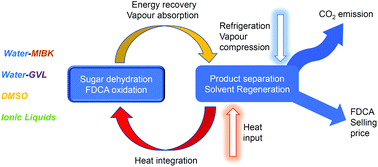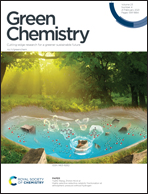From sugars to FDCA: a techno-economic assessment using a design concept based on solvent selection and carbon dioxide emissions
Abstract
The synthesis of the molecule 2,5-furandicarboxylic acid (FDCA) from sugars is key to unlocking the potential for the replacement of the oil derivative PET (polyethylene terephthalate) by polyethylene furanoate (PEF). Although much research and investment has been dedicated to the synthesis of FDCA, there remains limited commercial activity in this area due to the challenges related to the stability and isolation of the FDCA precursor, 5-hydroxymethylfurfural (HMF). High yields of HMF can be obtained from fructose at high loadings in water–organic solvent mixtures (methyl isobutyl ketone, MIBK; γ-valerolactone, GVL), dimethyl sulfoxide (DMSO) or ionic liquids. Each of these approaches suffers from various drawbacks in terms of catalyst development, product separation and environmental impact. It is therefore necessary to understand which of these processes has the potential for scale-up, while ensuring low environmental impact and a competitive selling price. In this study, a process simulation (rather than a life cycle assessment) was performed to evaluate the associated emissions and selling price of FDCA based on its production using different solvents. It was determined that the cost and CO2 emissions associated with the isolation of HMF undermine the economic and environmental viability of the transformation of sugars to FDCA. In contrast, a two-step, one-pot reaction represents an ideal solution to reduce both cost and environmental impact, making FDCA competitive with terephthalic acid (the corresponding precursor for PET). The choice of solvent and the process were then evaluated and ranked based on safety, CO2 emissions, selling price and state of development though a scoring methodology. A system based on a water/GVL mixture is closer to commercial applicability but the process is limited by extensive formation of humins, which reduces the overall yield of the process, increasing the minimum selling price of FDCA. Using DMSO or ionic liquids minimises emissions and leads to the lowest cost of FDCA but further study is needed to improve the oxidation step. This investigation analyses the possible routes to FDCA from sugars based on the current literature, placing the emphasis on process economics but also considering the CO2 emissions from processing the sugars.

- This article is part of the themed collection: Celebrating our 2021 Prizewinners


 Please wait while we load your content...
Please wait while we load your content...